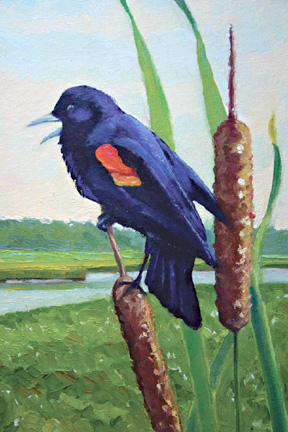
Volume XVII, Issue 37 # September 10 - September 16, 2009 |
 |
 |
Earth Journal by Gary Pendleton
 |
The glossy males go out of their way to see and be seen as they perch atop the tallest reeds while calling out a loud conk-a-ree! |
Red-Winged Blackbirds
The brightest contributor to autumn’s blackbird flocks
I’ve always had an interest in birds. When I was very young, a kind man named Joe lived a few doors away. He was very fond of a certain little redheaded kid. He gave me a button to wear that said I’m a Bird Watcher. He must have brought that button home from a trip to Memorial Stadium, where the Orioles played back in 1959 or ’60 or whatever year it was. I wonder who pitched that day: Was it Hoyt Wilhelm? Did Brooks get a hit?
Scientific name: Agelaius phoeniceusWhat to look for: A glossy black bird, 8-9 inches long, with bright red and yellow epaulets (shoulder patches). Females are similar in size and shape, but streaky gray, brown and white. Where to look: Marshes or anywhere near fresh water. In winter, they are often seen in large flocks around fields and woodlands.Places to visit: Jug Bay Wetlands Sanctuary in Anne Arundel County; Warriors Rest – American Chestnut Land Trust in Calvert County. |
Small gestures made by friendly adults can make big impressions on little kids. From that day, I have identified myself as a birdwatcher. A seed had been planted, and I noticed the common birds that lived near my home by the Susquehanna River.
Orioles are in the blackbird family, and all of this is a round-about way to get to something I wanted to say about another species of blackbird: It always surprises me when someone asks, What is the name of the black bird with red on its wings? I have to suppress an urge to act surprised. There is a lot of stuff that I don’t know, but I have known the name of the red-winged blackbird from the time I was old enough to cross the street by myself.
Red-winged blackbirds are one of the most abundant species in the U.S. They live in every state but are especially common near water. They are stocky, broad shouldered, with slender bills and medium-length tails. The adult males are glossy black and sport bi-color (red and yellow) epaulets. They go out of their way to see and be seen as they perch atop the tallest reeds while calling out a loud conk-a-ree!
Females are markedly different. Though they are the same size and shape, they wear camouflaged plumage that is streaked with gray and brown. They skulk down in the thick reeds in order not to be seen.
Beginning in the fall, huge mixed flocks of blackbirds form. Red-winged and rusty blackbirds, grackles and others gather into massive clouds of birds. These clouds of countless black specks stretch and bend as they move through the air, sometimes breaking apart and reforming as if controlled by a magnetic force.
In late September, if you are able to paddle the mid-Patuxent around Jug Bay, or a similar body of freshwater, you might find yourself canoeing amid streaming flocks of redwings and other blackbirds as they move restlessly about. It could be a nice way to end summer.